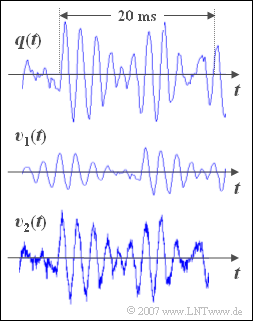Exercise 1.1: Music Signals
From LNTwww
On the right you see a ca. $\text{30 ms}$ long section of a music signal \(q(t)\). It is the piece „For Elise” by Ludwig van Beethoven.
- Underneath are drawn two sink signals \(v_1(t)\) and \(v_2(t)\), which were recorded after the transmission of the music signal \(q(t)\) over two different channels.
- The following controls allow you to listen to the first fourteen seconds of each of the three audio signals \(q(t)\), \(v_1(t)\) and \(v_2(t)\).
Originalsignal \(q(t)\)
Sinkensignal \(v_1(t)\)
Sinkensignal \(v_2(t)\)
Notes:
- The task belongs to chapter Prinzip der Nachrichtenübertragung.
Questions
Solutions
(1) Correct is the solution 2:
- In the marked range of $20$ milliseconds approx. $10$ oscillations can be detected.
- From this the result follows approximately for the signal frequency; $f = {10}/(20 \,\text{ms}) = 500 \,\text{Hz}$.
(2) Correct is the solution 1:
- The signal \(v_1(t)\) is undistorted compared to the original signal \(q(t)\). The following applies: $v_1(t)=\alpha \cdot q(t-\tau) .$
- Eine Dämpfung \(\alpha\) und eine Laufzeit \(\tau\) führen nicht zu Verzerrungen, sondern das Signal ist dann nur leiser und es kommt später als das Original.
(3) Richtig sind die Lösungsvorschläge 1 und 3:
- Man erkennt sowohl im dargestellten Signalverlauf \(v_2(t)\) als auch im Audiosignal additives Rauschen ⇒ Lösungsvorschlag 3.
- Der Signalrauschabstand beträgt dabei ca. $\text{30 dB}$; dies ist aber aus dieser Darstellung nicht erkennbar.
- Richtig ist aber auch der Lösungsvorschlag 1: Ohne diesen Rauschanteil wäre \(v_2(t)\) identisch mit \(q(t)\).
(4) Das Signal \(v_1(t)\) ist formgleich mit dem Originalsignal \(q(t)\) und unterscheidet sich von diesem lediglich
- durch den Amplitudenfaktor $\alpha = \underline{\text{0.3}}$ (dies entspricht etwa $\text{–10 dB)}$
- und die Laufzeit $\tau = \underline{10\,\text{ms}}$.
